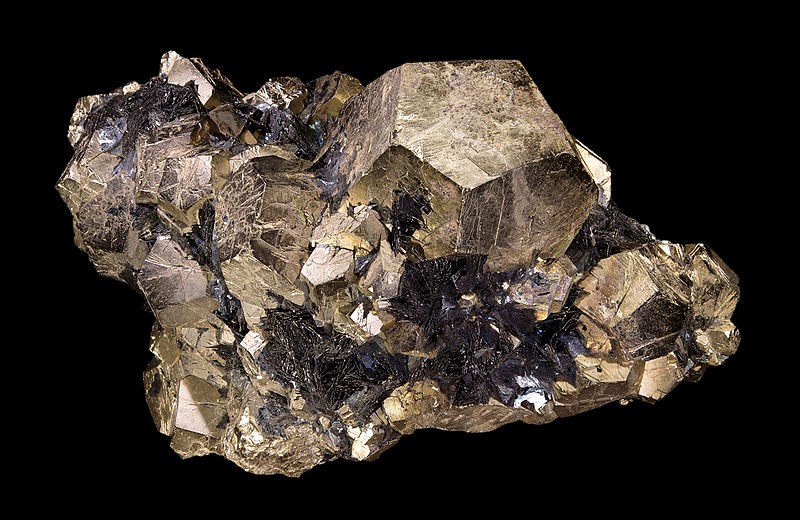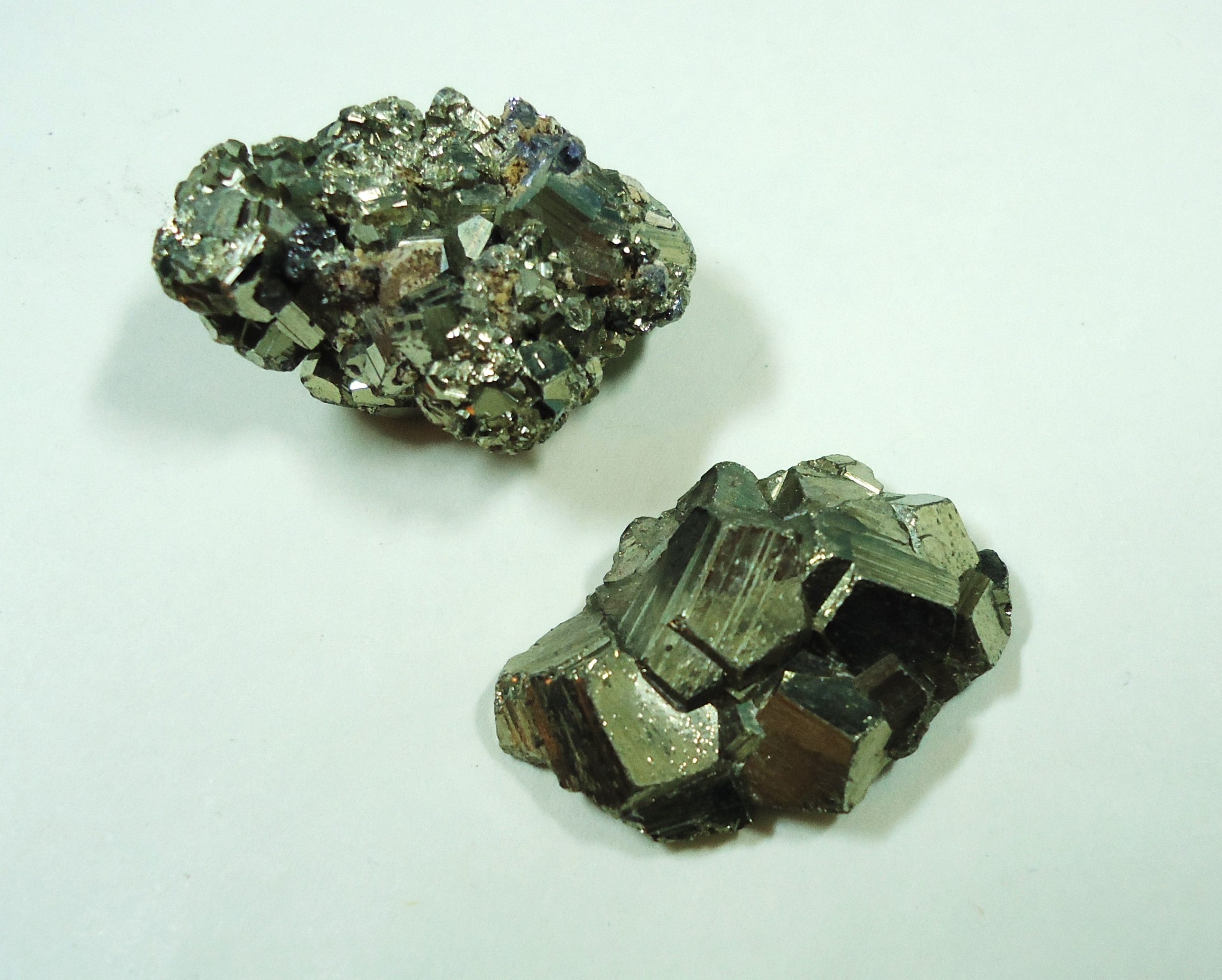Fool’s Gold
16/05/2024Daniel Fisher
Free & fully insured UK Delivery. Learn more
Secure & flexible payments. Learn more

Buyback Guarantee Learn more

Gold prospecting can be an exciting business, but detecting whether a material is actually gold can be tricky.
The term Fool’s Gold has been referred to for many years as particles in rocks which can deceive the prospector into thinking they’ve discovered gold when in fact, it’s something else entirely.
So what exactly is Fool’s gold, how did the term start, and how can we spot the differences with genuine gold?
Fool’s Gold refers to the mineral iron pyrite, which often resembles the appearance of genuine gold. However, unlike gold, iron pyrite is not a precious metal. Instead, it is composed of iron disulphide and has a metallic lustre that can fool even experienced prospectors.
One of the reasons Fool’s Gold can be so deceptive is its striking resemblance to real gold. It often appears as shiny, brassy-yellow crystals or masses, leading many to mistake it for the valuable precious metal. However, upon closer examination, differences in hardness, colour, and other physical properties become apparent.
The opportunity for confusing Fool’s Gold for genuine gold is abundant due to iron pyrite often being found in similar geological settings to gold. Both minerals can occur in veins, lodes, or deposits within rocks, particularly in areas where hydrothermal activity has occurred. These regions typically include:
Both gold and iron pyrite can form in quartz veins, which are fractures in rocks filled with mineral deposits. These veins often occur in metamorphic and igneous rocks.
Placer deposits are concentrations of minerals, including gold and iron pyrite, that have been eroded from their original source rocks and deposited by water action. They are commonly found in riverbeds, stream channels, and beaches.
Both gold and iron pyrite can precipitate from hot, mineral-rich fluids that circulate through fractures and faults in rocks. These hydrothermal deposits can occur in a variety of geological settings, including near volcanic activity or deep within the Earth’s crust.
While less common, both gold and iron pyrite can also be found in certain sedimentary rocks, particularly those formed in environments with high concentrations of organic material, such as black shale deposits.
While iron pyrite may not be sought by the gold miner, the presence of Fool’s Gold in certain geological formations can sometimes indicate the potential for gold mineralization nearby. However, it’s important to note that the presence of iron pyrite does not guarantee the presence of gold, as the two minerals can also form under different conditions and may occur independently of each other.
Free ultimate guide for keen precious metals investor
Throughout history, Fool’s Gold has played a significant role, both as a source of confusion and as a symbol of deception. Countless tales exist of individuals and civilizations mistaking iron pyrite for real gold, only to realize their folly later. These misconceptions have fuelled legends and folklore surrounding hidden treasures and lost riches, contributing to the enduring deception of Fool’s Gold.

Sometimes the existence of iron pyrite can cause large scale disappointment. In the late 1890s, gold was discovered in the Klondike region of the Yukon Territory in Canada, sparking a frenzied rush of prospectors hoping to strike it rich.
During the gold rush, many prospectors encountered Fool’s Gold alongside genuine gold deposits. The presence of iron pyrite in the Klondike goldfields added an extra layer of challenge for prospectors, as they had to carefully distinguish between genuine gold and the impostor mineral. Some prospectors even developed techniques for identifying Fool’s Gold, such as testing the hardness of the mineral or examining its colour and sheen under different lighting conditions.
The story of Fool’s Gold during the Klondike Gold Rush serves as a reminder of the excitement, challenges, and disappointments faced by those who sought their fortunes in the rugged wilderness of the North. It also highlights the importance of knowledge and experience in the pursuit of precious metals, as distinguishing between Fool’s Gold and real gold was crucial for success in the goldfields.
Beyond its literal meaning as a mineral, Fool’s Gold has also found its way into common parlance as a metaphor for something deceptive or illusory. “Fool’s Gold” is now regularly used metaphorically to describe situations, investments, or experiences that appear valuable or promising at first glance but ultimately turn out to be worthless or disappointing.

The expression ‘Fool’s Gold’ implies an asset that has no real intrinsic value. Perhaps the investment’s apparent worth is built on hype, naïve hope, or simple misjudgement, rather than solid tangible foundations.
The term fits perfectly within this metaphor, contrasting with real physical gold, which is famous for having an intrinsic value.
The contemporary application of the term “Fool’s Gold” to explain “too-good-to-be-true investments” has been widespread within certain asset classes and time periods.
During the dot-com bubble of the late 1990s, numerous internet start ups emerged, promising ground breaking technologies and astronomical returns for investors. Many of these companies were based in Silicon Valley, near the site of the original California Gold Rush. Investors poured money into these ventures, drawn by the allure of quick profits. However, as the bubble burst in the early 2000s, countless tech companies folded, revealing that much of the initial excitement was akin to Fool’s Gold. Despite the failures, a few standout companies like Amazon and Apple emerged as genuine successes.
In recent years, the rise of cryptocurrencies has led to a proliferation of digital assets, including meme coins and other speculative tokens. These cryptocurrencies often attract investors with promises of rapid gains and revolutionary technologies. However, many of these projects lack fundamental value or sustainable business models, leading some to label them as examples of Fool’s Gold in the digital age. Instances of pump-and-dump schemes and volatile price fluctuations further underscore the risks associated with investing in such assets. Many “gold bugs” will site these risks when comparing gold investment with Bitcoin.
The symbolic use of Fool’s Gold extending beyond just minerals, provides a cautionary reminder to exercise scepticism and due diligence in evaluating the true worth of investments and opportunities.
The figurative use of “Fool’s Gold” within the investment community has evolved a step further with the expression the “Greater Fool Theory”.
This concept describes a speculative mindset wherein investors buy overvalued assets, anticipating that they can sell them later to a “greater fool” at an even higher price. In simpler terms, it’s the belief that one can profit from an investment solely because there will always be someone else willing to pay a higher price, regardless of the asset’s intrinsic value.
This theory is often associated with typical Fool’s Gold situations where investments appear too good to be true or lack fundamental value. During market bubbles or periods of irrational exuberance, investors may disregard traditional valuation metrics and instead rely on the expectation of finding a “greater fool” to offload their investments onto.
The Greater Fool Theory has been applied to various investment scenarios throughout history, including the dot-com bubble of the late 1990s and the housing bubble of the mid-2000s. It serves as a cautionary reminder of the risks inherent in speculative investing and the importance of conducting thorough research and analysis before making investment decisions.
Our automated portfolio builder will provide suggestions based on various investment objectives
While it may seem like second best if you discover your nice shiny rock to contain Pyrite rather than gold, the mineral possesses unique properties and uses in its own right.

Pyrite is an iron sulphide mineral with the chemical formula FeS2. It typically forms cubic crystals or masses with a brassy-yellow colour and metallic gleam. Pyrite has a Mohs hardness of 6 to 6.5, making it relatively soft compared to genuine gold. Additionally, pyrite is brittle compared to gold’s malleability and can often exhibit cubic or octahedral cleavage to its architecture.

Genuine gold may possess a plethora of uses, but don’t assume that Pyrite is undesirable. Pyrite has been utilized for various purposes throughout history. In ancient times, it was used for producing sparks to start fires, leading to its nickname “firestone.” Pyrite has also been employed in the production of sulphur dioxide for sulfuric acid, a vital industrial chemical.
In modern times, pyrite continues to find applications in industry. It is used in the production of sulfuric acid, as a source of sulphur for sulphur dioxide, and as an additive in concrete to enhance its strength and durability.
Pyrite’s metallic brilliance ensures it resembles gold, making it a popular material in jewellery and ornamental objects. While pyrite lacks the intrinsic value of gold, its affordability and attractive appearance have led to its use in costume jewellery and decorative items.
While pyrite may resemble gold superficially, its value is significantly lower due to its abundance and lack of intrinsic worth. With an ounce of gold commanding more than $2,000/oz, pyrite’s worth is incomparable at around $1 per ounce.
Unlike gold, which has been prized for its rarity and durability throughout history, pyrite is relatively abundant and therefore lacks the same exclusivity.
However, its considerably lower price ensures it provides a desirable and cost-effective solution in certain circumstances. While the use of gold in electronics is limited due to it’s cost implications, Pyrite thrives in industries reliant on sulfuric acid production.
Utilising real gold to enhance the aesthetics of ornaments and other objects is prohibitive due to cost. But so-called Fool’s Gold provides a far cheaper sparkle. Similarly, the Pyrite Jewellery sector is thriving for providing great value items that look appealing
With the huge price differential, it’s crucial to know how to tell if gold is authentic, or if you’re holding a cheaper mimic. Luckily there are a few ways to detect if you’re looking at Fool’s Gold or the real thing.
While Fool’s Gold may bear a resemblance to real gold at first glance, there are key differences that can be observed with the naked eye, albeit experience will help. Understanding genuine gold’s unique properties is crucial to spotting these contrasts.
Pyrite typically has a brassy-yellow colour, while gold tends to have a brighter, more golden hue.
Pyrite has a metallic lustre that may appear shinier than gold, which often has a softer, more muted sheen.
Gold is relatively soft and can be scratched with a fingernail or a pocketknife, whereas pyrite is harder and more resistant to scratching.
Several straightforward tests can help differentiate between Fool’s Gold and real gold. The feasibility of these will require the pyrite to be extracted from any rock, and to have authentic gold for comparison purposes. For the amateur prospector, it will likely require combining several tests in order to come to a compelling conclusion.
Rub the mineral against a rough surface, such as an unglazed ceramic tile. Gold will leave a yellow streak, while pyrite will leave a greenish-black streak.
Gold is denser than pyrite, so it will feel heavier when compared to a piece of similar size. This may prove difficult to judge if the mineral is embedded within a rock, making comparison difficult.
Real gold is resistant to most acids, while pyrite will react and produce a sulfuric odour when exposed to nitric acid.
Pyrite is weakly magnetic, meaning it will be attracted to a magnet to some extent. In contrast, gold is not magnetic and will not be attracted to a magnet.
Check out what your gold is worth in our selling section
Accurately identifying Fool’s Gold (pyrite) versus real gold is paramount in mining and prospecting endeavours due to several critical reasons:
Mistaking pyrite for gold can lead to significant financial losses for mining operations. Time, labour, and resources expended on extracting pyrite, believing it to be gold, result in wasted efforts and diminished profitability.
Inaccurate identification poses safety risks to miners and prospectors. Working under the assumption that pyrite is genuine gold can lead to hazardous conditions and exposure to harmful substances. Accurate identification ensures the implementation of appropriate safety measures, safeguarding the well-being of workers.
Misidentifying pyrite as gold can have detrimental effects on the environment. Unnecessary excavation and processing of pyrite contribute to habitat destruction, soil erosion, and pollution of waterways. Accurate identification minimizes environmental disturbances, promoting responsible mining practices and conservation of natural resources.
While Fool’s Gold (pyrite) is a well-known term, the existence of “Fool’s Silver” is less common but still relevant. Unlike with Fool’s Gold, there’s no single mineral that is identified to mimic silver. Instead, there are a number of possible suspects which can fool the prospector into thinking they possess silver.
Perhaps silver’s aesthetics are less unique than gold’s, setting a lower bar for other substances to have a similar appearance. Minerals commonly confused with silver are Goethite, Hematite, Galena, and Molybdenite. Identification can usually be obtained by performing assessments such as the streak test.
While Fool’s Silver may not be as frequently used as the term Fool’s Gold, it can similarly pertain to investments that appear attractive at first glance but ultimately fail to deliver expected returns. In the context of silver markets, it may refer to speculative schemes, overvalued assets, manipulation, or fraudulent practices that exploit investors’ desires for quick profits.
Fool’s Gold, scientifically known as iron pyrite, is valued for its metallic lustre but holds little monetary worth compared to real gold. While it can occasionally contain trace elements like lithium, its primary use is ornamental and industrial. Investors should be cautious, as mistaking pyrite for genuine gold can lead to financial disappointment.
Fool’s Gold refers to iron pyrite, a mineral resembling gold in appearance but lacking its value. Beyond minerals, the term is metaphorically used in finance to describe investments that appear promising but turn out to be worthless. Originally, it specifically denoted iron pyrite due to its resemblance to real gold.
Iron pyrite, commonly referred to as Fool’s Gold for its golden hue, frequently appears in quartz veins. While prized for its metallic shine, pyrite is crucial in sulphur dioxide production, a key component in manufacturing sulfuric acid, a vital industrial chemical.
While Fool’s Gold (iron pyrite) and real gold can occur together in similar geological settings, their presence does not guarantee the presence of significant gold deposits. While gold can occasionally be found within pyrite, successful recovery depends on various factors and is not always feasible in mineable quantities.
Fool’s Gold, or iron pyrite, is often mistaken for real gold due to its shiny, metallic appearance. However, unlike genuine gold, pyrite is not a precious metal. Instead, it is a mineral composed of iron and sulphur. While visually similar, pyrite lacks the rarity and intrinsic value of precious metals like gold.
Image credits: Wikipedia Creative Commons and Mauro Cateb via Wikimedia Commons
Live Gold Spot Price in Sterling. Gold is one of the densest of all metals. It is a good conductor of heat and electricity. It is also soft and the most malleable and ductile of the elements; an ounce (31.1 grams; gold is weighed in troy ounces) can be beaten out to 187 square feet (about 17 square metres) in extremely thin sheets called gold leaf.
Live Silver Spot Price in Sterling. Silver (Ag), chemical element, a white lustrous metal valued for its decorative beauty and electrical conductivity. Silver is located in Group 11 (Ib) and Period 5 of the periodic table, between copper (Period 4) and gold (Period 6), and its physical and chemical properties are intermediate between those two metals.